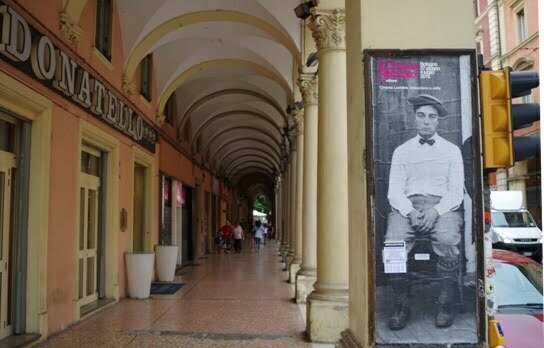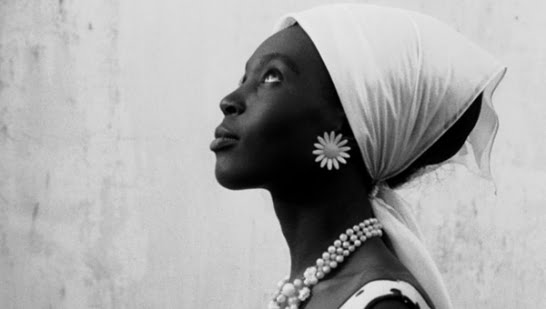
I spent three days last week at Il Cinema Ritrovato, the renowned festival of restored and classic films held each year in Bologna, Italy. To my great shame it has been twenty-two years since I last attended the festival (though I was in the vicinity for a talk I gave three years ago). The reason for such severe neglect is simple – the weather. It’s hot in Bologna in July, and I was not designed to withstand temperatures much about 25 degrees C, to be honest. But I was brave, I clung to the shade, I learned to move slowly, and with amusing irony it was actually hotter in the UK.
I was there primarily because I helped programme the minor festival strand on the Velle and O’Connor film family, as noted previously. I was also keen to see the films of Tunisian film pioneer Albert Samama Chikly, whose history I knew something of but whose work I’d never encountered. Il Cinema Ritrovato runs over eight days, and has grown considerably in ambition and importance since I last turned up in 1993. The 368-page catalogue with some 400 films on offer shows how grand Bologna now is, and how essential it has become to the discerning cinéaste with a travel budget. As in 1993, its chief pleasure is how it covers all periods of film history, happily mixing silent with sound films, and across all filmmaking countries. You could explore the early films of Ingrid Bergman, jazz at the movies, post-war Italian rarities, Iranian new wave cinema, films from 100 years ago, films on the Armenian genocide, the films of Leo McCarey, colour film in Japan, the works of Renato Castellani, and a whole lot more, across four indoor venues and two outdoor ones.
The proper way to do things would be to immerse oneself in it totally and experience all eight days, wholly enveloped within interlocking other worlds. Budgets and other logical constraints being what they are, many such as myself come for a few days only, and you have to pick and choose. I went for the Velle/O’Connor films (naturally), Chikly, the production of Universal subsidiary Bluebird Photoplays, and some one-off specials.
The history behind magician-turned-filmmaker Gaston Velle, his cinematographer son Maurice, and Maurice’s British scriptwriting partner Mary Murillo aka O’Connor is a fascinating one, but their individual films are very different. Gaston Velle was the greatest artist of the trio, and the féerie films that he made for Pathé in the 1900s are magical delights that display a very particular grace and delight in the fantastical. There is Métamorphoses du Roi de Pique (1903) where are magician (Velle himself) does card tricks, then has the King of Spades expand to life size and play a game with him (the perplexed look on the king’s face is a treat); or the astonishing Japonaiseries (1904), an oriental fantasy that ends with the film image shown on a grid of bricks which then tumble out of the screen. Velle’s work shows how the stage magician’s craft could be transmuted into filmcraft, for which technical skill was required but what was essential first was a wholly filmic imagination. Velle’s films, with their legerdemain, wit, artfully applied colour and liberal use of Pathé’s troupe of dancing girls, more than merit a major study by someone. He is the equal of his better-known film magician peers Georges Méliès and Segundo de Chomón.

His son Maurice was a cinematographer on French feature films of the 1920s, and a very talented one it would seem. I could only see one of the films of his on show, La Princesse aux Clowns (1924), which was accorded the honour of an open-air screening in the Piazetta Pier Paolo Pasolini outside the festival’s main Lumière cinema, with a lush score provided by Donald Sosin. Every seat was filled and a good many were left standing at the back (including yours truly, hence the photo above with the screen somewhat obscured by trees). The film is a handsomely-designed and gorgeously-photographed Ruritanian romance about a reluctant king, with clever plot twists and opportunities for disguise, and it delighted the audience (many of them young and probably quite new to silent film I think). It just goes to show how wholly entertaining silent feature films still lurk in the archives as yet unseen (this must have been the film’s first public screening in ninety years). We have still to go on looking, and learning.
The English titles for La Princesse were written by Mary Murillo, whose career I have been researching. I wasn’t able to see any other of her films, though the British sound film My Old Dutch (1934) seems to have gone down well.
Instead I saw some of the output of Bluebird Photoplays, a low-budget subsidiary of Universal Studios, which produced (on the evidence displayed at Bologna) some charming and inventive dramas with actors on their way to being stars or who were never quite going to get there. Little Eve Edgarton (1916) featured Ella Hall as a botanist brought up in the jungle with her stuffy father, who faces many challenges trying to cope with the jungle that is life in the West. Though it played with every cliché it could (of course she wore glasses, of course her hair was in a bun), it was a film of simple charm. The Little White Savage (1919) had a particularly ingenious premise – the Roanoke colony, established by Sir Walter Raleigh, which disappeared in 1590 according to history, has somehow survived and continues to live as though it is the sixteenth century. It is discovered by modern-day entrepreneurs, who take back one of the colony (Carmel Myers) to feature as a fairground attraction. Unfortunately it misses all the opportunities that would have been for a comical clash of cultures, and has a cop-out ending where the story turns out to have been a hoax all along. Shame – someone should make a proper movie out of the idea.
Also in this strand, though not a Bluebird production as such, was Universal’s The Dumb Girl of Portici (1916). This is one of the most astonishing films of the 1910s, yet only now has it been restored with additional material added to the largely complete print held by the BFI. Its fame lies in the starring role it gives to the ballerina Anna Pavlova, in her only film bar some dances recorded on the set of The Thief of Baghdad in the 1920s. Its neglect probably lies on account of its extreme histrionics. It is based on an opera by Daniel Auber, which tells of a violent uprising against Spanish rule in Naples in 1647. The film is operatic in style, heavy on the costumes, heavy on the moustaches, heavy on the waving of arms and the wringing of hands. Pavlova (playing the dumb girl) dances rather than acts as such, and it features the archetypal cast of thousands enacting bloody riot after bloody riot – after 45 mins or so of tedious exposition, the film launches into over an hour of climax. It just goes on and on – ludicrous really, but also an astonishing feat of directorial management. She was Lois Weber, leading American female director of the 1910s, and it is evidence of the great respect held for her at the time that she was put in charge of one of Universal’s most expensive films to date. There are some adroit directorial touches, and I won’t easily forget the sight of Pavlova passing among a row of poles bearing severed heads. John Sweeney’s piano accompaniment, using themes from Auber and with Frank Bockius on percussion, was an astonishing tour de force.

And then there was Chikly. Albert Samama Chikly (1872-1934) was a Tunisian Jew who organised the first film screening, of Lumière films, in Tunisia in 1897. He went on to become one of the African continent’s most important, enterprising, and long-lasting pioneers of film and photography. He shot many actuality films, selling some to European producers, including Charles Urban, who issued his Tunny Fishing in Tunis (1905) the surviving print of which I helped to identify but – curses, curses – I got to the festival too late to see it screened. He ran his own cinema, the Cinemato-Chikli, then was employed by the French Army as a photographer and filmmaker during the First World War. A substantial amount of this footage survives at the French military archives and we saw some marvellous extracts, informal and observant scenes behind and close to the front line of French troops and some African troops. These included quite astonishing scenes of French troops from Verdun being taken for a day at the seaside and cavorting naked among the waves.
Apart from the WWI work few of Chikli’s films survive, and the programme was padded out with early Tunisian films from other hands, and ‘orientalist’ productions of the period, including Rex Ingram’s incomplete turkey, The Arab (USA 1924). But, magically, the two fiction films that Chikli made survive, albeit in incomplete form only: Zohra (1922) and Ain el-Ghezal or La fille de Carthage (1924). Both feature his daughter, Haydée Chikli, who on this evidence had real star presence (she also scripted both films). The first is about a shipwrecked French girl brought up by Bedouins. The second is about a woman escaping an arranged marriage. What survives of the films suggest that Chikli had little interest in drama as such, and simply applied his documentary understanding to the films, the chief purpose of which was to reveal the local culture that he cherished and understood. They are fragments of great charm and obvious skill, and deserve to be seen by many more people.

I saw other films, including a digital restoration of The Third Man shown in the main Piazza Maggiore (preceded by a tedious and rather embarrassing film on Italian women made by Orson Welles) and a selection of Laurel and Hardy shorts at the same venue, preceded by an earnest speaker instructing us on how we were supposed to find the duo funny. I attended an intriguing session on film restoration, with comparisons between film and digital restorations of Warlock, Pretty Poison and Dr Strangelove (only for the latter did the digital look like the more authentically-restored piece of work).
But the film of the festival for me, by some margin, was Ousmane Sembène’s La Noire de… aka Black Girl (Senegal 1966). In fact I think it is one of the best films I’ve ever seen, period. It tells of a Senegalese girl, Diouana. who is employed by a French middle class couple as a maid and nanny, initially in Senegal and then in France, where her sense of entrapment drives her into silence and then to a final act of despairing rebellion. The film’s most haunting moments come at the end, when the Frenchman returns to Senegal to apologise to Diouana’s mother, only to be pursued out of town by a small boy bearing an African mask which has featured as a motif through the film. The film is about the emergence of Africa from out of colonialism and how self-understanding will bring about a return of power. In film study terms, it is about the transference from the colonial gaze to an African gaze. Yet there is no pretension about the film at all. It says very simply what needs to be said, though images composed with great technical ability and political understanding. That it was the first film Sembène had made, indeed one of the very first African features of the modern era, is extraordinary. Martin Scorsese’s Film Foundation has restored the film, and I hope it finds a DVD release and gets seen as widely as possible. Those who know it already revere it; those who have yet to may end up revising their understanding of film history.